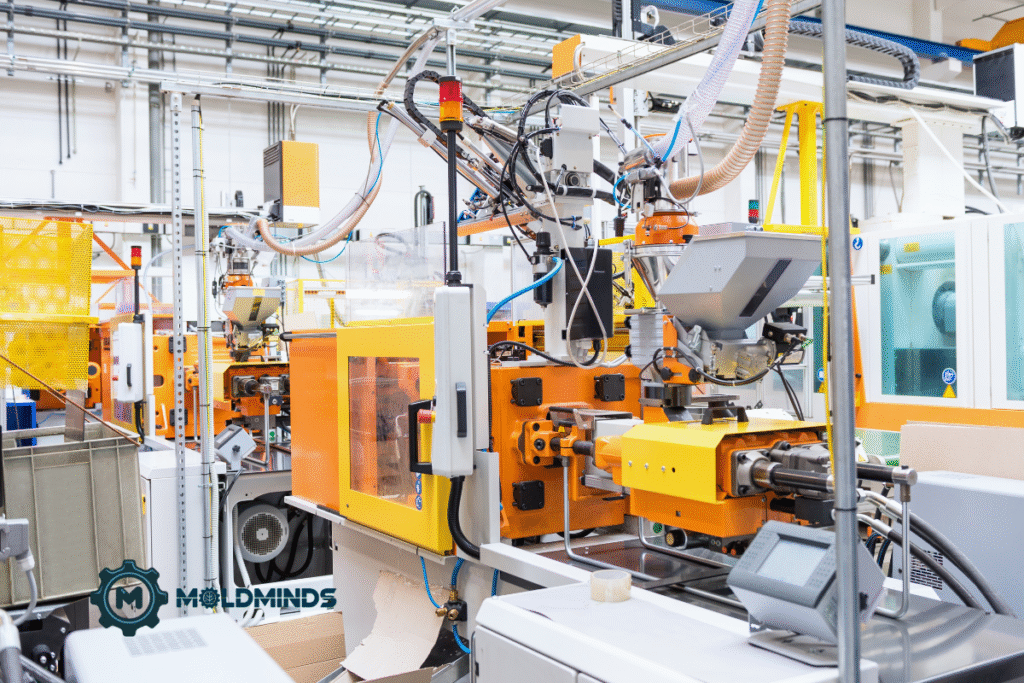
Plastic injection molding makes many of the plastic parts we use every day, from phone cases to car parts. It’s fast, reliable, and cost-effective, which makes it a popular choice for modern manufacturing. Choosing the right company matters, because having products made with speed and quality can set your business apart. This guide breaks down how top plastic injection molding companies work and what to look for when picking the best partner for your needs.
What is Plastic Injection Molding?
Plastic injection molding shapes our daily lives more than most people realize. The process is everywhere—from the dashboard in your car to the buttons on your TV remote. Understanding how it works helps explain why so many companies rely on it to create strong, high-quality parts at scale. Let’s break down how the process works, which materials are common, and what gives it clear benefits over other manufacturing methods.
The Basics of the Injection Molding Process
At its core, injection molding uses two main resources: plastic pellets and a specially designed mold. The process unfolds in a series of controlled steps:
- Melting the Plastic: Small pellets of plastic get loaded into a heated barrel. There, the heat turns them into a thick, flowing liquid.
- Injection: A screw or plunger pushes the molten plastic into a closed mold under high pressure.
- Cooling and Solidifying: Once inside the mold, the plastic starts to cool and take the shape of the cavity.
- Ejection: When the part is solid, pins or plates push the finished piece out of the mold, ready for any extra steps like trimming.
This quick cycle repeats thousands—or even millions—of times, making it easy to produce large numbers of identical parts.
Common Materials Used in Injection Molding
Different products need different plastics. The most common injection molding materials each bring their strengths to the table:
- Polypropylene (PP): Lightweight, flexible, and tough. Used for containers, caps, and automotive parts.
- Acrylonitrile Butadiene Styrene (ABS): Durable and easy to mold. Good for computer housings, toys, and appliance parts.
- Polyethylene (PE): Versatile, with excellent chemical resistance. Found in bottles, tubs, and household goods.
- Polystyrene (PS): Clear or foamable. Often used in packaging and disposable items.
- Polycarbonate (PC): Impact-resistant and transparent. Ideal for eyewear lenses and safety shields.
Some companies blend plastics or use engineered resins to meet special needs, like added heat resistance or extra strength.
Key Advantages Over Other Manufacturing Methods
Why do so many manufacturers pick injection molding? The benefits stack up quickly:
- Low per-part cost for big runs: Once a mold is made, producing more parts gets cheaper the more you make.
- High repeatability and consistency: Each molded part matches the last one, which is critical in industries like automotive and medical devices.
- Complex shapes are possible: Injection molding handles angles, curves, and intricate details that would be tough or expensive with other methods.
- Quick production cycles: Parts can be made in seconds, letting companies meet tight deadlines.
- Minimal material waste: Excess plastic can often be recycled, keeping costs and waste lower.
These strengths explain why plastic injection molding is the first choice for companies aiming to produce reliable, cost-effective plastic products at scale.
Factors to Consider When Choosing a Plastic Injection Molding Company
Picking the right plastic injection molding company shapes the future of your product. From turning your idea into a finished part, the right partner brings skill, speed, and support. Not every company is the same. The differences show up in their machines, people, and promises. Here’s what to look at before signing on the dotted line.

Technical Capabilities and Machinery
The heart of any injection molding company sits in its machines and the skills of its staff. Top companies invest in modern, well-maintained equipment that can:
- Handle a range of part sizes, from tiny gears to large panels
- Run various materials, both standard and specialized plastics
- Support advanced mold designs with multiple cavities or moving parts
Ask about their automation, press sizes (measured in tons), and mold-making tools. Can they handle tight tolerances or tricky designs? Can their machines create the detailed features or glossy finishes your parts need? A shop with up-to-date, high-tonnage presses and modern controls will deliver faster runs and cleaner results.
Experience and Industry Certifications
Years in business matter. They show that a company has solved problems, adapted, and built a steady flow of happy customers. Look at their project history. Do they serve companies like yours? Have they handled designs with similar size, material, or complexity?
Certifications, like ISO 9001, back up their promises. These stamps show that the company meets recognized quality and organization standards. Other industry-specific certificates can matter, too—like IATF 16949 for auto parts or ISO 13485 for medical devices. These badges don’t just look good; they prove the company runs a tight, consistent process.
Production Volume and Lead Times
Your supplier must match your production needs, whether you need a thousand parts or a million. Some companies do best with high-volume, repeat jobs. Others focus on smaller, custom runs. Make sure their capacity fits your plans today—and as you grow.
Ask for typical lead times. How long does it take from order to delivery? Fast turnaround can matter when speed gets your product to market ahead of the competition. Reliable companies share clear schedules and stick to them.
Quality Assurance and Testing Processes
A good part looks right and works as designed, every single time. Reputable molding companies set up strict quality checks to keep standards high throughout production. Quality assurance touches every part of the job:
- Incoming material checks to verify the plastic is right
- In-process inspections at key steps
- Final checks on surface finish, size, and function
Some shops use advanced tools, like coordinate measuring machines or automated vision systems, for more reliable results. They may provide documentation, inspection reports, and samples on request. If a company talks openly about their testing steps, it shows they take quality seriously and will stand by their parts.
Choosing a plastic injection molding company is not just about price or promises. Dive into their skills, experience, and systems to make sure they match what your project demands.
Leading Plastic Injection Molding Companies in the United States
The United States is home to some of the most advanced plastic injection molding companies in the world. Their work shapes everyday products, medical devices, automotive parts, and more. Knowing who the leaders are and what they do best can save time and stress when you need quality and reliability. In this section, we look at top companies and the projects that showcase their strengths.
Company Profiles and Specializations
Across the U.S., a few names rise to the top for their experience, technical skill, and customer support. Here are standout companies and what makes each unique:
- Protolabs (Minnesota)
Protolabs is known for quick-turn plastic injection molding. They help startups and established brands move quickly from idea to product. Their digital platform speeds up quoting and production, supporting projects from rapid prototyping to full-scale production. Protolabs is especially strong in delivering small to mid-size batches with fast lead times. - EVCO Plastics (Wisconsin)
EVCO shines in complex part production and automation. With several facilities in the U.S., Mexico, and China, they offer global capacity with local support. EVCO matches high-volume needs for medical, packaging, and industrial clients. Their in-house engineers help with part design, tooling, and automation solutions. - Mack Molding (Vermont/North Carolina)
Mack Molding stands out for large parts and contract manufacturing. Their experience spans medical devices, heavy industry, and consumer goods. Mack Molding handles everything from mold design to part assembly, so you get a full-service partner. They’re trusted for their engineering support and ability to manage challenging, high-precision work. - Xometry (Maryland)
Xometry connects businesses with a network of vetted partners, making it easy to get parts made quickly. Their online platform handles quoting and order tracking for custom projects. Xometry covers a wide range of industries, but is especially useful for prototype and low-to-mid volume production. They offer an easy way for smaller companies and innovators to access expert injection molding services.
Each company brings its own blend of strengths, whether it’s speed, scale, personal design help, or access to new technology.
Case Studies: Successful Projects
The true test for any plastic injection molding company is how their work holds up in real projects. Here are a few successes that highlight what the top companies can deliver:
- Protolabs: Rapid Medical Part Production
When the pandemic created sudden demand for ventilator parts, Protolabs responded in days, not weeks. Their digital quoting and automated toolmaking let them produce tools fast and deliver thousands of medical-grade plastic parts on tight deadlines. Hospitals were able to get the parts they needed, showing Protolabs’ value for urgent, quality-focused projects. - EVCO Plastics: High-Volume Consumer Packaging
EVCO helped a leading food brand launch a new line of packaging. The challenge was to mass-produce custom containers with consistent quality, speed, and minimal waste. EVCO set up automated presses and quality checks that supported millions of units with near-zero defects. Their team also worked with the client to refine the part and mold design, making the launch smooth and hassle-free. - Mack Molding: Complex Medical Device Assembly
Mack Molding partnered with a medical device company to make a multi-part diagnostic tool. The project called for tight tolerances and a sterile, finished product. Mack’s team managed the entire process, including tool building, molding, assembly, and packaging. The result was a finished device ready for market, meeting strict FDA standards. - Xometry: Streamlined Prototyping for Startups
A robotics startup used Xometry to produce early prototypes of a new smart device. With Xometry’s platform, they uploaded their design, got instant pricing, and tracked progress online. They received high-quality prototypes in days, helping them secure investor funding and move ahead with field testing faster than expected.
These companies prove their worth not just with claims, but with results that make a difference for their clients. Whether you’re looking to build the next high-volume hit or bring a quick-turn prototype to life, these U.S. leaders have proven they can deliver on time and on spec.
Emerging Trends and Technologies in Plastic Injection Molding
Innovation is shaking up the plastic injection molding industry in ways that matter to buyers and manufacturers alike. Companies are turning to smarter machines, eco-friendly methods, and new types of molding that open doors for medical, electronics, and other tight-tolerance parts. Let’s break down today’s top trends driving these changes.

Automation and Digitalization in Molding
Automation is moving from buzzword to standard practice. Factory floors look and run differently now, with robotics and smart software taking care of more steps than ever. Here’s what’s changing:
- Robots handle repetitive jobs like loading parts, trimming, and inspection. This boosts speed and keeps human hands out of risky spots.
- Smart sensors and real-time data help teams catch problems early. Machines “talk” to each other, dialing in temperature, pressure, and timing for every cycle.
- Digital tracking and scheduling make production smoother. Cloud platforms help managers and customers follow orders from start to finish.
- Remote monitoring lets experts spot trouble or fine-tune machines—even from far away.
These upgrades mean fewer mistakes, quicker changeovers, and faster delivery times. For buyers, that equals more reliable parts and better value with every project.
Sustainable Materials and Eco-Friendly Practices
Plastic molding companies hear the call for greener manufacturing loud and clear. Many are shifting how they make and source parts:
- Bio-based and recycled plastics are showing up in more projects. These materials lower environmental impact while still meeting industry standards.
- Closed-loop systems recycle scrap and runner waste back into the process, cutting both trash and raw material costs.
- Smarter energy use helps lower a factory’s carbon footprint. This might mean using new equipment that draws less power or setting up energy audits to spot waste.
- Water recycling reduces strain on local resources, especially in big plants.
Going green isn’t just a trend—it’s a lasting shift. Customers value companies that can deliver both quality and a smaller environmental impact.
Micro Molding and High-Precision Solutions
The demand for tiny, ultra-precise parts is growing, especially in medical, electronics, and automotive fields. Micro molding sets new standards for what’s possible in miniature plastics:
- Micro molding creates parts measured in milligrams or millimeters—think surgical staples, hearing aid pieces, or tiny device gears.
- Advanced tooling and machines handle ultra-fine features, often with tolerances tighter than a human hair.
- Special plastics get used for these parts, chosen for bio-compatibility, strength, or heat resistance.
This isn’t everyday molding. Micro molding takes special knowledge, tools, and quality checks. For industries that demand perfection at a tiny scale, this trend opens up whole new design choices.
Plastic injection molding companies that embrace these advances are ready for the future—faster, greener, and ready for almost anything their customers can imagine.
How to Work Effectively with a Plastic Injection Molding Partner
Finding the right plastic injection molding partner is only half the journey. Working together in a clear, productive way can save time and money, and help you get the results you want. Laying a strong foundation now means fewer surprises later. Here’s how you can get the most out of your partnership—right from the start.
Defining Project Requirements
Clarity pays off. Before your project begins, know exactly what you want. This means sharing detailed specs and goals with your molding partner. Don’t just focus on dimensions—talk about the final look, function, and even the feel of your product.
Key details to cover together:
- Product drawings and 3D models: These let engineers spot challenges early.
- Material selection: Share any special needs—like flexibility, heat resistance, or color.
- Quantity goals: Are you ordering a small batch or millions of parts? This shapes everything from mold cost to delivery dates.
- Tolerance and finish: If the part needs to fit with other pieces or needs a smooth surface, say so up front.
- Testing and compliance needs: If your part must meet standards (like for food or medical use), be specific.
The more precise your requirements, the easier it is for your molding partner to suggest better materials, spot red flags, and keep the project on track.
Prototyping and Iterative Design
Rushing from concept to full production almost always costs more down the line. Instead, treat the design as a process where you learn and refine as you go.
Working with your molding partner, you can:
- Start with quick prototypes to test ideas or fit.
- Review early samples for problems like deformation, sink marks, or incomplete fills.
- Make incremental tweaks before investing in expensive, final molds.
Think of prototyping as a test drive. It helps identify design issues, choose stronger materials, or spot assembly problems early. Good partners expect and even encourage this back-and-forth. It’s their job to speak up if they see design risks, so listen closely and stay flexible.
Regular feedback and small changes at this stage keep surprises, waste, and rework to a minimum when you start mass production.
Communication and Collaboration Best Practices
Good communication turns a basic order into a long-term win. Keep the conversation active, open, and detailed. No one likes rework or missed deadlines.
Best practices for collaboration:
- Set clear points of contact. Know who is handling technical questions, logistics, and billing.
- Use shared documents and tools. Online platforms for drawings, feedback, and tracking updates make it easy to stay organized.
- Schedule regular check-ins. Even a quick weekly sync can keep progress smooth and spot potential delays early.
- Document changes. Track all revisions—big or small—to avoid confusion over which file is the latest.
- Stay open to advice. Your molding partner sees thousands of projects. Their feedback might save you money or prevent problems.
Simple, steady communication builds trust and saves everyone time. It also makes your project run smoother, from first quote to delivered parts. The best results come when both sides listen, share, and work toward the same goals.
Conclusion
Choosing the right plastic injection molding company can shape the success of your product and your business. Each provider brings a mix of skills, technology, and service that may be a good fit—or not—for your needs. Look at your own requirements, from material type to production volume, and use the insights above as a checklist.
The right partnership goes beyond price; it’s about trust, quality, and support every step of the way. Take time to weigh your options, ask the tough questions, and don’t be afraid to push for clarity before you commit.
Thanks for reading—your feedback and questions are always welcome. If you’re ready to make your next project a success, start by reaching out to a short list of companies and see which ones match your goals best.
